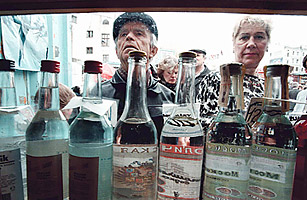
Russia has made an unofficial New Year’s resolution: this year, it’s time to cut down on the booze. On Jan. 1, the Kremlin adopted new minimum-price standards for vodka that will nearly double the cost of a half-liter bottle of the national spirit, from $1.69 to $3. The move, part of President Dmitri Medvedev’s anti-alcoholism campaign, is designed to curb Russians’ excessive drinking. With a per capita alcohol consumption twice as high as that of the U.S. and an active underground market for homemade alcohol , Russians aren’t about to give up their vodka so easily. The 2010 price hikes are just the latest battle in Russia’s centuries-long war against the demon drink.
To understand the grip vodka has on Russian culture, one need only to look at its name: vodka is a diminutive form of the word voda — Russian for water. The average Russian drinks 4.75 gal. of pure alcohol a year, mostly in the form of vodka. Distilled from grains or potatoes, it has no real taste. It is not sipped; it is not savored. In fact, there’s no real reason to drink it except to get drunk. With an alcohol content of between 40% and 55% , vodka is consumed as a shot, usually in the afternoon or evening, followed by a salty snack: fish, pickles, jellied meat or sauerkraut. After the food comes another shot. Then more food. Shot, food, shot, food — and so on until the Russian winter seems a little less cold.
Vodka’s origins are murky, but the favored legend traces its arrival in the country to Genoese merchants who traveled to Moscow in the 14th century and met with Prince Dmitry Ivanovich. Monks in the Kremlin’s Chudov Monastery began distilling the first Russian spirits some time in the 15th century. Ivan the Terrible served vodka to his oprichniki — the special police force that carried out his violent and, well, terrible orders. To facilitate their drunken revelry, Ivan opened kabaks, or taverns, that served vodka and other alcohol . By 1648, with Russians developing a strong taste for drink, a third of the country’s male population was in debt to the state-owned kabaks. When Moscow started collecting the debts, peasants responded by distilling and distributing vodka at home.
Peter the Great — who was rumored to drink up to half a gallon of vodka a day — cracked down on home-brewed alcohol by creating liquor licenses, which were required in order to sell vodka. Catherine the Great made it illegal for anyone other than the aristocracy to purvey it, which boosted the drink’s quality — and the Czarina’s coffers. By 1860, more than 40% of government revenue came from vodka. The distillation process had improved , leading to increased consumption. By 1913, Russian citizens could boast one unlicensed, bootlegging distillery for every 10 households. Drunkenness was so rampant that in 1914, Czar Nicholas II took the drastic step of making alcohol illegal.
That year, the Russian army revoked shops’ liquor licenses and confiscated over 140 million gal. of vodka. Prohibition remained in effect during the 1917 revolution and subsequent civil war. But when the teetotaling Bolsheviks ran low on funds, they rethought their stance; by 1925 vodka was back on the shelves of state-run dispensaries. In World War II, every Russian soldier at the front was given a daily ration of vodka — roughly a shot’s worth — and by the 1950s Russia had fallen completely off the wagon. In 1958, the communist youth organization Komsomol Pravda complained that members of its national soccer team were so drunk they couldn’t score a goal from five yards away.
The temperance movement flared up again in the 1985 when Gorbachev launched an all-out campaign to eradicate drunkenness, revoking liquor licenses, banning vodka consumption at Soviet embassies and razing vineyards , earning himself the nickname Mineral’nyi Sekretar
Drinking increased after the 1991 fall of the Soviet Union. Although personally fond of vodka, Boris Yeltsin abolished the state monopoly and instituted laws to keep drinking in check. He outlawed sidewalk liquor kiosks — prompting merchants to build tiny phone booth–size stores instead. He also raised the price of vodka, which only encouraged the black market for samogon.
Today, Russians’ annual consumption of alcohol is higher than that of any other nationality in the world. Russian men have a life expectancy of just 60 years — largely attributed to alcoholism. Rosspirtprom, a government-owned company, oversees more than 100 vodka distilleries and controls an estimated 40% of Russian market. While President Medvedev’s move, praised by the state-sanctioned vodka producers, almost certainly will fail to solve Russia’s drinking problem, it’s likely to generate significant income for Moscow.
Read “The Danger of Doing Business in Russia.”
See 25 people who mattered in 2009.